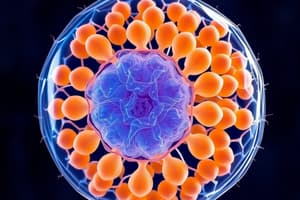Podcast
Questions and Answers
Where are the enzymes involved in ATP production located within the mitochondrion?
Where are the enzymes involved in ATP production located within the mitochondrion?
Inner membrane
How do mitochondria reproduce?
How do mitochondria reproduce?
Binary fission
What structures are revealed in the chloroplasts?
What structures are revealed in the chloroplasts?
Thylakoids
What is the function of the thylakoid membrane in chloroplasts?
What is the function of the thylakoid membrane in chloroplasts?
Which organelle provides a surface area for protein and lipid synthesis, forms a pathway for transporting molecules within the cell, and provides a storage area for synthesized molecules?
Which organelle provides a surface area for protein and lipid synthesis, forms a pathway for transporting molecules within the cell, and provides a storage area for synthesized molecules?
What is the function of Golgi bodies in the cell?
What is the function of Golgi bodies in the cell?
What is the primary function of the Golgi apparatus in eukaryotic cells?
What is the primary function of the Golgi apparatus in eukaryotic cells?
How is the DNA organized in eukaryotic cells?
How is the DNA organized in eukaryotic cells?
What is the purpose of the nuclear envelope in eukaryotic cells?
What is the purpose of the nuclear envelope in eukaryotic cells?
What is the process that ensures each daughter cell receives the same number of chromosomes as the original parent cell during cell division?
What is the process that ensures each daughter cell receives the same number of chromosomes as the original parent cell during cell division?
What is the relationship between the endoplasmic reticulum and the nuclear envelope in eukaryotic cells?
What is the relationship between the endoplasmic reticulum and the nuclear envelope in eukaryotic cells?
What is the role of histones in the organization of DNA within the nucleus of eukaryotic cells?
What is the role of histones in the organization of DNA within the nucleus of eukaryotic cells?
What is the main difference in the structure of the cytoplasm between prokaryotes and eukaryotes?
What is the main difference in the structure of the cytoplasm between prokaryotes and eukaryotes?
Describe the structure and function of the chloroplast in eukaryotic cells.
Describe the structure and function of the chloroplast in eukaryotic cells.
What is the role of the endoplasmic reticulum (ER) in eukaryotic cells?
What is the role of the endoplasmic reticulum (ER) in eukaryotic cells?
Describe the structure and function of the Golgi apparatus in eukaryotic cells.
Describe the structure and function of the Golgi apparatus in eukaryotic cells.
What is the role of the nucleolus in the nucleus of eukaryotic cells?
What is the role of the nucleolus in the nucleus of eukaryotic cells?
Describe the structure and function of the thylakoid system in chloroplasts.
Describe the structure and function of the thylakoid system in chloroplasts.
Flashcards are hidden until you start studying




